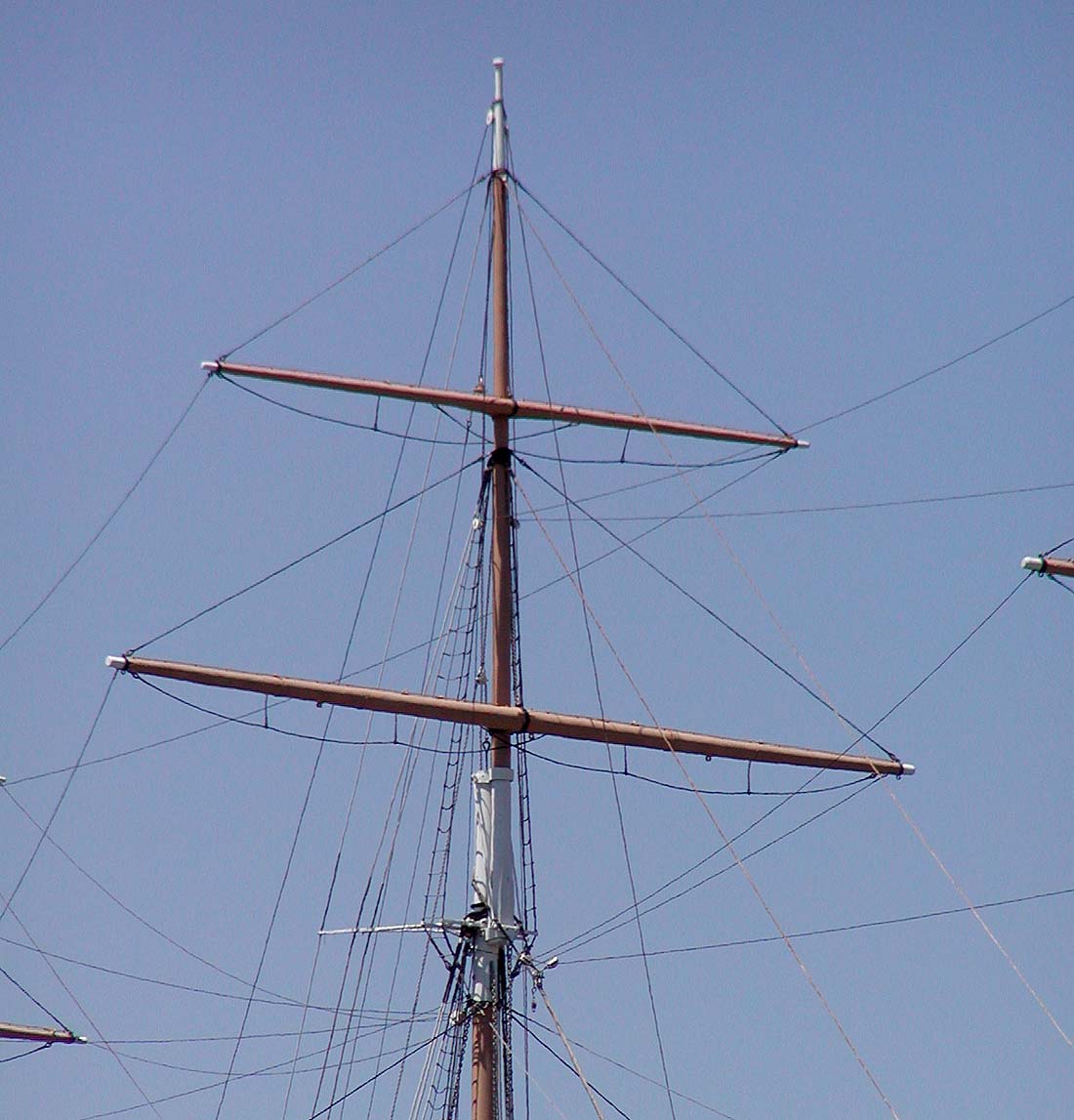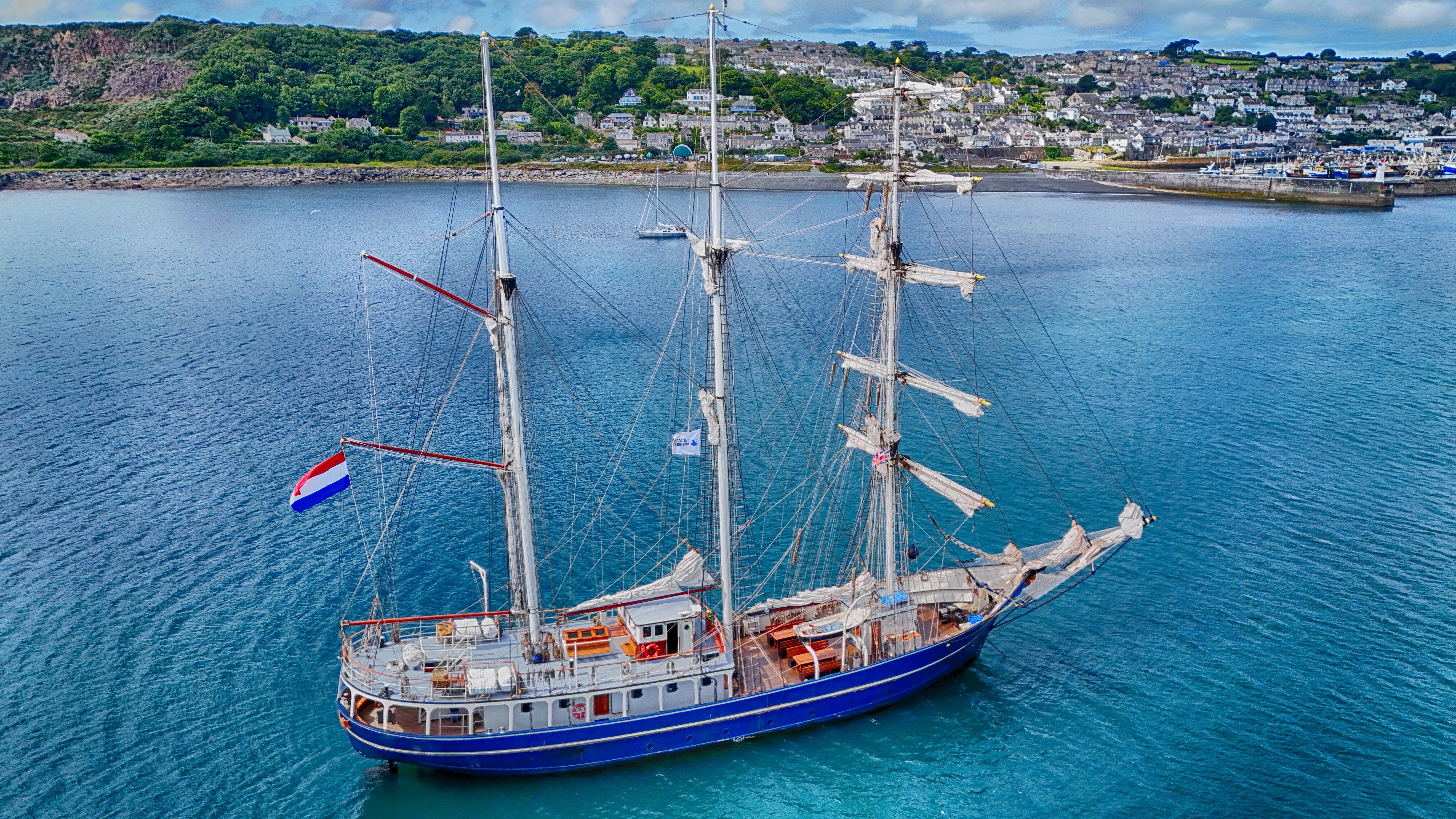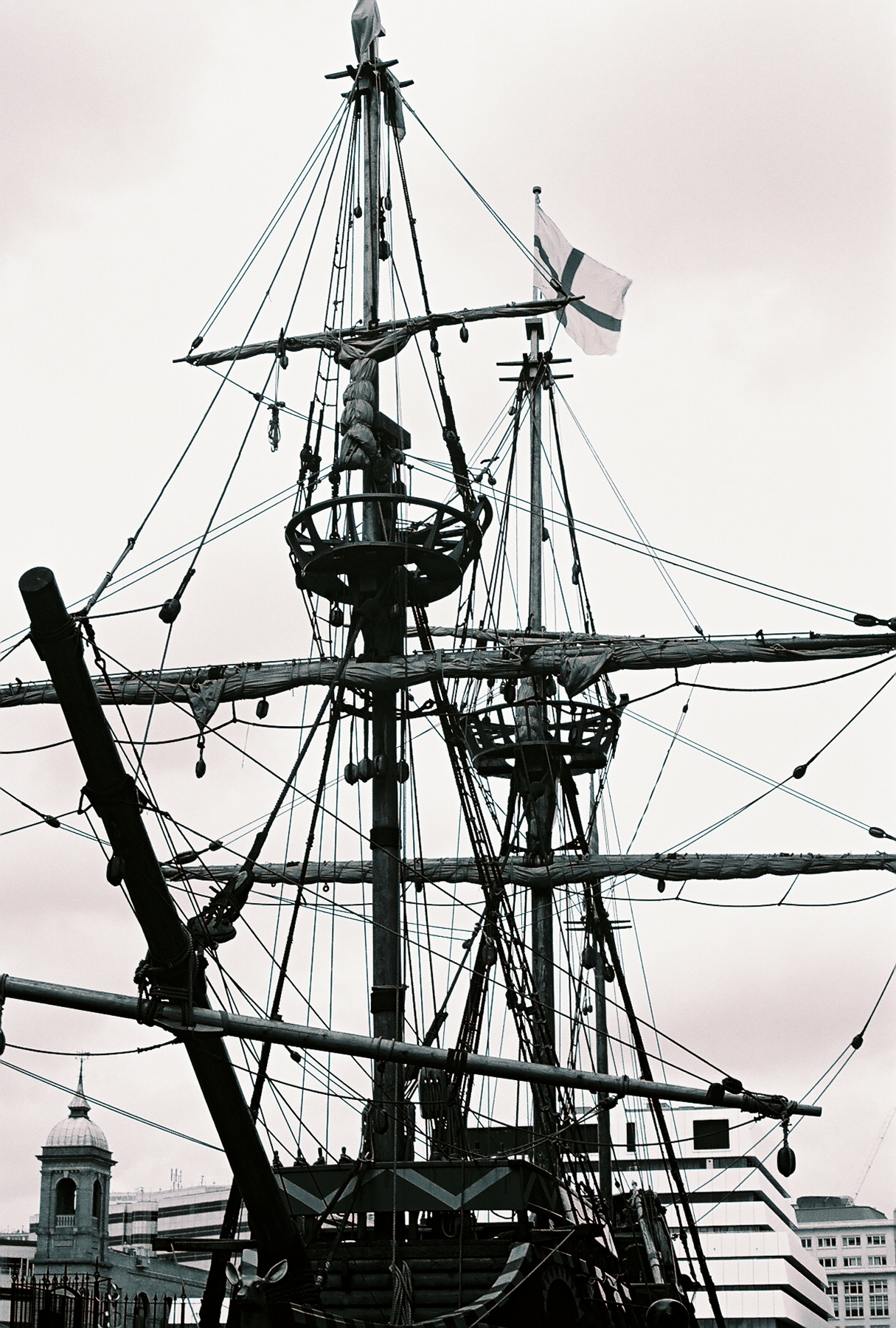|
Topmast
The masts of traditional sailing ships were not single spars, but were constructed of separate sections or masts, each with its own rigging. The topmast is one of these. The topmast is semi-permanently attached to the upper front of the lower mast, at the top. Its shrouds run to the edges of the top, rather than to the sides of the hull, though long shrouds leading well aft to the hull, more in the manner of backstays, are sometimes seen. In accordance with the standard square rig sail plan, the topmast carries the topsail. In the late 19th century, however, topsails became so big that merchant ships began to divide them into two separate sails for easier handling; since these were still on the topmast they were known as upper and lower topsails to preserve the consistency of the naming scheme. The majority of large square-riggers today carry separate upper and lower topsails. The main topmast carries the upper end of the main-topmast-staysail; a mizzen-topmast may carry th ... [...More Info...] [...Related Items...] OR: [Wikipedia] [Google] [Baidu] |
Top (sailing Ship)
The top on a traditional square rigged ship is the platform at the upper end of each (lower) Mast_(sailing), mast. This is not the masthead "crow's nest" of the popular imagination – above the mainmast (for example) is the main-topmast, main-topgallant-mast and main-royal-mast, so that the top is actually about 1/4 to 1/3 of the way up the mast as a whole. An important purpose of the top is to anchor the Shroud (sailing), shrouds of the topmast that extends above it. Shrouds down to the side of the hull would be at too acute an angle from the mast, so crosstrees run sideways out from the mast to spread the topmast shrouds. These crosstrees rest on two trestle trees running fore and aft, which themselves are placed on top of the cheeks of hounds, bolted to the sides of the mast. Placing a few timbers onto the crosstrees produces a useful platform, the top. The futtock shrouds carry the load of the upper shrouds into the mast below. Up until late in the 17th century, the top serv ... [...More Info...] [...Related Items...] OR: [Wikipedia] [Google] [Baidu] |
Topsail
A topsail ("tops'l") is a sail set above another sail; on square-rigged vessels further sails may be set above topsails. Square rig On a square rigged vessel, a topsail is a typically trapezoidal shaped sail rigged above the course sail and below the topgallant sail where carried, on any mast (i.e., a fully rigged ship would have a foremast topsail, a mainmast topsail, and a mizzen topsail). A full rigged ship will have either single or double (i.e., "split" upper and lower) topsails on all masts, the single or lower topsail being the second sail above the deck and the upper topsail where so rigged being the third. Although described as a "square" sail, a topsail on a full rigged ship refers not to the sail's shape but to it and its yard being rigged square (i.e., at a right angle) to the vessel's keel rather than in line with it (in which case it would be called a fore-and-aft rig or a fore-and-aft rigged sail) ; a square rigged topsail is nearly always trapezoidal in sha ... [...More Info...] [...Related Items...] OR: [Wikipedia] [Google] [Baidu] |
Mast (sailing)
The mast of a sailing vessel is a tall spar, or arrangement of spars, erected more or less vertically on the median line of a ship or boat. Its purposes include carrying sails, spars, and derricks, giving necessary height to a navigation light, look-out position, signal yard, control position, radio aerial, or signal lamp. Large ships have several masts, with the size and configuration depending on the style of ship. Nearly all sailing masts are guyed. Until the mid-19th century, all vessels' masts were made of wood formed from a single or several pieces of timber which typically consisted of the trunk of a conifer tree. From the 16th century, vessels were often built of a size requiring masts taller and thicker than from single tree trunks. On these larger vessels, to achieve the required height, the masts were built from up to four sections (also called masts). From lowest to highest, these were called: lower, top, topgallant, and royal masts. Giving the lower section ... [...More Info...] [...Related Items...] OR: [Wikipedia] [Google] [Baidu] |
Tall Ship
A tall ship is a large, traditionally-rigging, rigged sailing vessel. Popular modern tall ship rigs include topsail schooners, brigantines, brigs and barques. "Tall ship" can also be defined more specifically by an organization, such as for a race or festival. History Traditional rigging may include square rigs and gaff rigs, usually with separate Mast (sailing), topmasts and topsails. It is generally more complex than modern rigging, which utilizes newer materials such as aluminum and steel to construct taller, lightweight masts with fewer, more versatile sails. Most smaller, modern vessels use the Bermuda rig. Author and master mariner Joseph Conrad (who spent 1874 to 1894 at sea in tall ships and was quite particular about naval terminology) used the term "tall ship" in his works; for example, in ''The Mirror of the Sea'' in 1906. Henry David Thoreau also references the term "tall ship" in his first work, ''A Week on the Concord and Merrimack Rivers'', quoting "Down o ... [...More Info...] [...Related Items...] OR: [Wikipedia] [Google] [Baidu] |
Rigging
Rigging comprises the system of ropes, cables and chains, which support and control a sailing ship or sail boat's masts and sails. ''Standing rigging'' is the fixed rigging that supports masts including shrouds and stays. ''Running rigging'' is rigging which adjusts the position of the vessel's sails and spars including halyards, braces, sheets and vangs. Etymology According to the Encyclopædia Britannica Eleventh Edition "rigging" derives from Anglo-Saxon ''wrigan'' or ''wringing'', "to clothe". The same source points out that "rigging" a sailing vessel refers to putting all the components in place to allow it to function, including the masts, spars, sails and the rigging. History Theophrastus in his '' History of Plants'' ( 300 BCE) states that the rigging on King Antigonus' fleet was made from papyrus reed. Types of rigging Rigging is divided into two classes, ''standing'', which supports the mast (and bowsprit), and ''running'', which controls the orienta ... [...More Info...] [...Related Items...] OR: [Wikipedia] [Google] [Baidu] |
Shroud (sailing)
On a sailing ship, the shrouds are the standing rigging which holds the mast (sailing), mast up from side to side. There is frequently more than one shroud on each side of the boat. Usually a shroud will connect at the top of the mast, and additional shrouds might connect partway down the mast, depending on the design of the boat. Shrouds terminate at their bottom ends at the Chainplate, chain plates, which are tied into the hull. They are sometimes held outboard by Chains (nautical), channels, a ledge that keeps the shrouds clear of the gunwales.''The Lore of Ships,'' ed. by Bengt Kihlberg. Göteborg :Tre tryckare & New York: Holt, Rinehart & Winston, 1963. Shrouds are attached symmetrically on both the port (nautical), port and starboard sides. For those shrouds which attach high up the mast, a structure projecting from the mast must be used to increase the angle of the shroud at the attachment point, providing more support to the mast. On most sailing boats, such structures ... [...More Info...] [...Related Items...] OR: [Wikipedia] [Google] [Baidu] |
Hull (watercraft)
A hull is the watertight body of a ship, boat, submarine, or flying boat. The hull may open at the top (such as a dinghy), or it may be fully or partially covered with a deck. Atop the deck may be a deckhouse and other superstructures, such as a funnel, derrick, or Mast (sailing), mast. The line where the hull meets the water surface is called the waterline. General features There is a wide variety of hull types that are chosen for suitability for different usages, the hull shape being dependent upon the needs of the design. Shapes range from a nearly perfect box, in the case of scow barges, to a needle-sharp surface of revolution in the case of a racing multihull sailboat. The shape is chosen to strike a balance between cost, hydrostatic considerations (accommodation, load carrying, and stability), hydrodynamics (speed, power requirements, and motion and behavior in a seaway) and special considerations for the ship's role, such as the rounded bow of an icebreaker or the flat bot ... [...More Info...] [...Related Items...] OR: [Wikipedia] [Google] [Baidu] |
Backstay
A backstay is a piece of standing rigging on a sailing vessel that runs from the mast to either its transom or rear quarter, counteracting the forestay and jib. It is an important sail trim control and has a direct effect on the shape of the mainsail and the headsail. Backstays are generally adjusted by block and tackle, hydraulic adjusters, or lines leading to winches. Types Backstays may be ''permanent'' or ''running''. Permanent backstay A permanent backstay is attached to the top of the mast. Running backstays appear in pairs attached about two-thirds of the way up the mast (sometimes at multiple locations along the length of the mast). In general, most modern sailboats have a permanent backstay and some have a permanent backstay combined with running backstays. Backstays are not always found on all vessels, especially smaller ones. A permanent backstay is attached at the top of the mast and may or may not be readily adjustable. In a masthead rig, tensioning the perma ... [...More Info...] [...Related Items...] OR: [Wikipedia] [Google] [Baidu] |
Square Rig
Square rig is a generic type of sail plan, sail and rigging arrangement in which a sailing ship, sailing vessel's primary driving sails are carried on horizontal spar (sailing), spars that are perpendicular (or wikt:square#Adjective, square) to the median plane of the keel and masts of the vessel. These spars are called and their tips, outside the lifts, are called the . A ship mainly rigged so is called a square-rigger. In "customs and traditions of the Royal Navy, Jackspeak" (Royal Navy slang), it also refers to the uniforms of the Royal Navy, dress uniform of Junior Ratings. History Single sail square rigs were used by the ancient Egyptians, the Phoenicians, the Greeks, the Romans, and the Celts. Later the Scandinavians, the Germanic peoples, and the Slavs adopted the single square-rigged sail, with it becoming one of the defining characteristics of the classic “Viking” ships.The Viking ship's single square-rigged sail. http://Longshipco.org/sail.html Retrieved 2018-8- ... [...More Info...] [...Related Items...] OR: [Wikipedia] [Google] [Baidu] |
Steel
Steel is an alloy of iron and carbon that demonstrates improved mechanical properties compared to the pure form of iron. Due to steel's high Young's modulus, elastic modulus, Yield (engineering), yield strength, Fracture, fracture strength and low raw material cost, steel is one of the most commonly manufactured materials in the world. Steel is used in structures (as concrete Rebar, reinforcing rods), in Bridge, bridges, infrastructure, Tool, tools, Ship, ships, Train, trains, Car, cars, Bicycle, bicycles, Machine, machines, Home appliance, electrical appliances, furniture, and Weapon, weapons. Iron is always the main element in steel, but other elements are used to produce various grades of steel demonstrating altered material, mechanical, and microstructural properties. Stainless steels, for example, typically contain 18% chromium and exhibit improved corrosion and Redox, oxidation resistance versus its carbon steel counterpart. Under atmospheric pressures, steels generally ... [...More Info...] [...Related Items...] OR: [Wikipedia] [Google] [Baidu] |
Sailing Ship Components
Sailing employs the wind—acting on sails, wingsails or kites—to propel a craft on the surface of the ''water'' (sailing ship, sailboat, raft, windsurfer, or kitesurfer), on ''ice'' (iceboat) or on ''land'' ( land yacht) over a chosen course, which is often part of a larger plan of navigation. From prehistory until the second half of the 19th century, sailing craft were the primary means of maritime trade and transportation; exploration across the seas and oceans was reliant on sail for anything other than the shortest distances. Naval power in this period used sail to varying degrees depending on the current technology, culminating in the gun-armed sailing warships of the Age of Sail. Sail was slowly replaced by steam as the method of propulsion for ships over the latter part of the 19th century – seeing a gradual improvement in the technology of steam through a number of developmental steps. Steam allowed scheduled services that ran at higher average speeds than saili ... [...More Info...] [...Related Items...] OR: [Wikipedia] [Google] [Baidu] |








